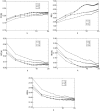Quantile graphs for EEG-based diagnosis of Alzheimer's disease
- PMID: 32502204
- PMCID: PMC7274384
- DOI: 10.1371/journal.pone.0231169
Quantile graphs for EEG-based diagnosis of Alzheimer's disease
Abstract
Known as a degenerative and progressive dementia, Alzheimer's disease (AD) affects about 25 million elderly people around the world. This illness results in a decrease in the productivity of people and places limits on their daily lives. Electroencephalography (EEG), in which the electrical brain activity is recorded in the form of time series and analyzed using signal processing techniques, is a well-known neurophysiological AD biomarker. EEG is noninvasive, low-cost, has a high temporal resolution, and provides valuable information about brain dynamics in AD. Here, we present an original approach based on the use of quantile graphs (QGs) for classifying EEG data. QGs map frequency, amplitude, and correlation characteristics of a time series (such as the EEG data of an AD patient) into the topological features of a network. The five topological network metrics used here-clustering coefficient, mean jump length, betweenness centrality, modularity, and Laplacian Estrada index-showed that the QG model can distinguish healthy subjects from AD patients, with open or closed eyes. The QG method also indicates which channels (corresponding to 19 different locations on the patients' scalp) provide the best discriminating power. Furthermore, the joint analysis of delta, theta, alpha, and beta wave results indicate that all AD patients under study display clear symptoms of the disease and may have it in its late stage, a diagnosis known a priori and supported by our study. Results presented here attest to the usefulness of the QG method in analyzing complex, nonlinear signals such as those generated from AD patients by EEGs.
Conflict of interest statement
The authors have declared that no competing interests exist.
Figures






References
-
- Organization WH. Dementia:. Switzerland: World Health Organization; 2012.
-
- Budson A, Solomon P. Memory Loss, Alzheimer’s Disease, and Dementia. New York: Elsevier; 2015.
-
- Hyman BT, Van Hoesen GW, Damasio AR, Barnes CL. Alzheimer’s disease: cell-specific pathology isolates the hippocampal formation. Science. 1984;225(4667):1168–1170. - PubMed
-
- Feldman HH, Woodward M. The staging and assessment of moderate to severe Alzheimer disease. Neurology. 2005;65 10.1212/WNL.65.6_suppl_3.S10 - DOI
Publication types
MeSH terms
LinkOut - more resources
Full Text Sources
Medical

